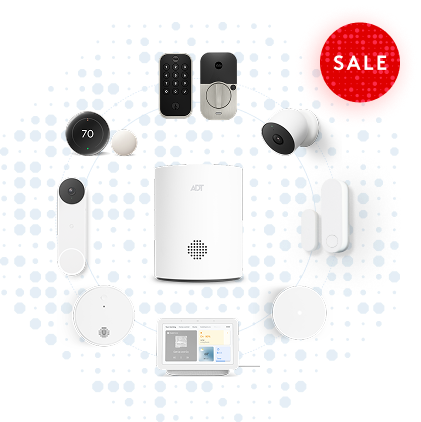2025 SAFETY REPORT
Safe-ish to secure: Moving beyond half-measures for home safety
New ADT research conducted via market research company, Prodege in May 2025, explores the widespread use of partial home security measures, revealing how comprehensive solutions can better help protect families, homes, and well-being.
As security risks continue to evolve, this study provides an in-depth look at the behavioral patterns, emotional impacts, and technology adoption shaping home safety in 2025.



The divide between intention and action
Across the country, many Americans want to feel safe at home, but how they go about achieving that safety varies widely. Some rely on appearance-based deterrents, like signs and decoy cameras. Others invest in smart technology and monitoring systems.
The divide between intention and effective action is the focus of ADT’s 2025 Home Security Survey. By examining both ineffective habits and promising innovations, this report offers a roadmap from "Safe-ish" behaviors to truly secure living.
Key findings at a glance
- Nearly 2 in 5 Americans (38.1%) use fake security items like signs or decoy cameras to prevent criminal activity
- 23.7% use easily guessable passcodes for their doors or garages, such as birthdays, anniversaries, repeating or sequential numbers
- 38.0% always or occasionally leave their door unlocked while at home, 20% leave windows open while away
- 11.4% have experienced a home break-in of some kind within the past two years
- Nearly 1 in 4 (23.8%) have had a package stolen from their doorstep, most commonly in the afternoon between the hours of 12 PM and 6 PM (45.6%)
- Following a theft or break-in event, 40.2% reported feeling a loss of trust in their neighborhood and 24.2% felt less safe in their home
The growing prevalence of theft
Theft, whether packages or break-ins, disrupts households financially and emotionally. Basic deterrents rarely stand up to real threats.


reported home break-ins


experienced package theft in the last two years


fell victim to vehicle theft
These events often disrupt daily life, increase household tension, and lead to longer-term safety concerns.
The emotional toll of theft
After experiencing an incident of theft, the loss extends far beyond missing items. It affects mental well-being, disrupts sleep, and erodes the sense of safety at home. Among those who have experienced theft,
35%
felt helpless or violated
24%
feel less safe in their homes after experiencing theft
40%
lost trust in their neighborhood following a theft
Where safe-ish falls short
Common habits and decoy devices are no substitute for true home protection. While well-intentioned, these approaches are often rooted in misconceptions about deterrence and affordability.
Many of these behaviors are driven by convenience but ultimately increase vulnerability.
Yet, 72% of those relying on habits like these admit they’re only occasionally effective at preventing theft or break-ins.
Use fake security items such as signs, lights, or cameras


Always or occasionally leave the front door unlocked while at home


Leave packages unattended on porches for four or more hours


Hide spare keys under rocks, doormats or flowerpots


Many of these behaviors are driven by convenience but ultimately increase vulnerability.
Yet, 72% of those relying on habits like these admit they’re only occasionally effective at preventing theft or break-ins.
The rise of smart security
A growing share of Americans are adopting smart solutions to strengthen home protection and reduce vulnerability. These technologies provide real-time visibility and responsiveness that passive measures cannot.


Use alarm systems


Rely on professionally monitored alarm systems


Use delivery tracking or alerts to reduce the risk of package theft
These tools are often paired with mobile alerts and cloud storage, increasing their overall effectiveness.
A path forward
Homeowners have an opportunity to move from partial to comprehensive protection through better awareness and the use of technology. The shift from "safe-ish" to secure starts with rethinking outdated habits and choosing smarter solutions.
Replace fake items with smart cameras and monitoring apps
Consistently secure entry points, especially for the 26% who sometimes leave doors unlocked
Engage in neighborhood programs to rebuild trust, especially where 39% reported a loss of community confidence
Reduce sleep disruption and emotional stress with reliable monitoring systems
Consider integrated tools that combine doorbell cameras, motion sensors, and alerts for layered protection
A path forward
Homeowners have an opportunity to move from partial to comprehensive protection through better awareness and the use of technology. The shift from "safe-ish" to secure starts with rethinking outdated habits and choosing smarter solutions.
Replace fake items with smart cameras and monitoring apps
Consistently secure entry points, especially for the 26% who sometimes leave doors unlocked
Engage in neighborhood programs to rebuild trust, especially where 39% reported a loss of community confidence
Reduce sleep disruption and emotional stress with reliable monitoring systems
Consider integrated tools that combine doorbell cameras, motion sensors, and alerts for layered protection
Methodology
ADT commissioned this national survey in partnership with Prodege Research. It includes responses from 3,000 U.S. adults, representing a cross-section of renters and homeowners across all housing types. Data collection occurred in May 2025, with stratified weighting applied to ensure demographic and regional representation. The findings offer a snapshot of modern safety behaviors and perceptions, reinforcing the need for smarter, more consistent home security practices.
Customize your ideal system




